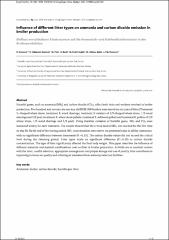| dc.contributor.author | Knežević, Slobodan | |
| dc.contributor.author | Vidaković Knežević, Suzana | |
| dc.contributor.author | Pajić, Marko | |
| dc.contributor.author | Ružić, Zoran | |
| dc.contributor.author | Đukić Stojčić, M. | |
| dc.contributor.author | Živkov-Baloš, Milica | |
| dc.contributor.author | Đorđević, M. | |
| dc.date.accessioned | 2021-07-27T08:53:18Z | |
| dc.date.available | 2021-07-27T08:53:18Z | |
| dc.date.issued | 2021 | |
| dc.identifier.issn | 1612-9199 | |
| dc.identifier.uri | https://repo.niv.ns.ac.rs/xmlui/handle/123456789/398 | |
| dc.description.abstract | Harmful gases, such as ammonia (NH3) and carbon dioxide (CO2), affect both birds and workers involved in broiler
production. Five hundred and seventy-six one-day-old ROSS 308 broilers were reared on six types of litter (Treatment
1: chopped wheat straw; treatment 2: wood shavings; treatment 3: mixture of 1/3 chopped wheat straw, 1/3 wood
shavings and 1/3 peat; treatment 4: wheat straw pellets; treatment 5: softwood pellets and treatment 6: pellets of 1/3
wheat straw, 1/3 wood shavings and 1/3 peat). Using chamber emission of harmful gases, NH3 and CO2 were
measured weekly for each treatment. The results showed that the critical level of NH3 was reached for the first time
on day 28. By the end of the rearing period, NH3 concentrations were above the permitted value in all the treatments,
with no significant difference between treatments (P > 0.05). The carbon dioxide values did not exceed the critical
level during the fattening period. Litter types made no significant difference (P > 0.05) to carbon dioxide
concentrations. The type of litter significantly affected the final body weight. This paper describes the influence of
different materials and material combinations used as litter in broiler production. As birds are in constant contact
with the litter, careful selection, appropriate management and proper storage and use of poultry litter contributes to
improving in-house air quality and reducing air emissions from animal production facilities. | en_US |
| dc.description.sponsorship | This study is part of the first author’s PhD thesis. The research was supported by the Ministry of Education Science
and Technological Development, Republic of Serbia as a part of the Project numbers TR 31084 and TR 31071. | en_US |
| dc.language.iso | en | en_US |
| dc.publisher | German Branch of the World's Poultry Science Association | en_US |
| dc.source | European Poultry Science | en |
| dc.subject | Ammonia | en_US |
| dc.subject | broiler | en_US |
| dc.subject | carbon dioxide | en_US |
| dc.subject | harmful gas | en_US |
| dc.subject | litter | en_US |
| dc.title | Influence of different litter types on ammonia and carbon dioxide emission in broiler production | en_US |
| dc.type | Article | en_US |
| dc.identifier.doi | 10.1399/eps.2021.XX | |

